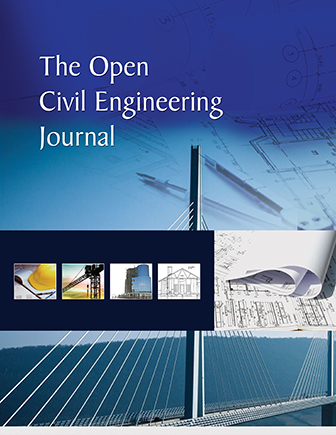All published articles of this journal are available on ScienceDirect.
Early-Stage Enhancement of Engineering Properties of Low Plastic Silt Using Waste Glass Powder
Abstract
Introduction
Soil stabilization is crucial for preventing foundation instability and enhancing the longevity of structures underlain by weak subsoil layers. Incorporating environmentally friendly soil amendments, such as Waste Glass Powder (WGP), is a practical approach among various stabilization techniques for shallow applications. This study explored the early-stage applicability of WGP for enhancing the mechanical properties of soil classified as ML under the Unified Soil Classification System (USCS).
Methods
Crushed WGP, obtained from recycled glass, was blended with soil at 2%, 4%, 6%, 8%, 10%, and 12% by dry weight. The effects were assessed through Liquid and Plastic Limits (LL & PL), standard proctor compaction, Unconfined Compressive Strength (UCS), and California Bearing Ratio (CBR) tests.
Results
The test results indicated that WGP reduced the plasticity of soil, lowering the Liquid Limit (LL), Plastic Limit (PL), and Plasticity Index (PI) to 18, 14, and 4, respectively, at 12% WGP. The Maximum Dry Density (MDD) increased up to 8% WGP before declining, while the Optimum Moisture Content (OMC) showed a consistent decrease. The 7-day UCS peaked at 210 kN/m2 with a 6% WGP, representing a 53.3% improvement over untreated soil, before decreasing to 136 kN/m2 at a 12% WGP content. Additionally, the 7-day CBR values showed significant enhancement when WGP was added. Both unsoaked and soaked CBR increased, and the highest values were discovered to be 31 and 13, respectively.
Discussion
This research highlights that utilizing WGP supports environmental sustainability by diverting waste from landfills and reducing environmental hazards. Furthermore, it minimizes dependence on conventional binders like cement and lime, thereby lowering carbon emissions. According to the results presented here, a 6% to 8% WGP may be optimal for enhancing soil properties at the early stage of improvement, especially for low plastic silt, providing an economical and environmentally compatible approach to soil stabilization.
Conclusion
The findings of this study strongly support earlier investigations underscoring the prospect of WGP as a sustainable substitute for conventional stabilizers in geotechnical engineering applications. The viability of using WGP to stabilize other soil types, particularly problematic soils, should be rigorously explored to establish its long-term sustainability.


